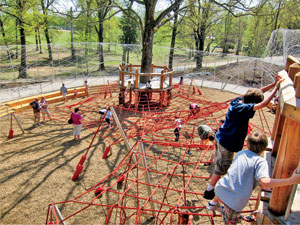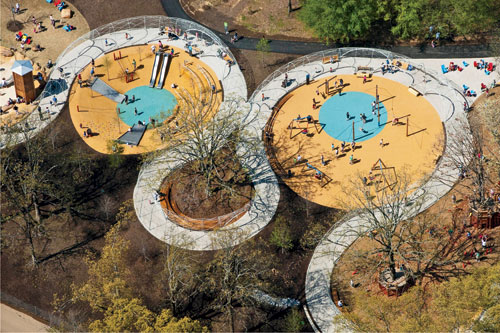Site Specific
Preliminary Guidelines
| Credit Gategories SITES' 15 prerequisites and 51 credits are organized into nine categories that address a range of issues relating to the development of a landscape project. |
||||||
|
||||||
To support this complex biogeochemical dance, more than 50 experts divided among five technical subcommittees (hydrology, vegetation, soil, materials, and human health and well-being) undertook the daunting task of developing an organized set of specific and verifiable strategies that could be applied to any type of site in any bioregion.
A report was released in 2007 calling for public feedback, and the development team received hundreds of comments in response. These were reviewed and incorporated as appropriate to create a document that followed the format of LEED. “We didn’t want to reinvent the wheel, nor did we want to create any market confusion, so we used LEED as a model,” explains SITES director Danielle Pieranunzi. This undoubtedly will make it easier for USGBC to incorporate elements of SITES into LEED v4, the version of the rating system slated to launch in 2013.
The SITES preliminary guidelines and performance benchmarks are divided into nine categories that address an array of issues relating to the development of a landscape project: site selection; pre-design assessment and planning; water; soil and vegetation; materials selection; human health and well-being; construction; operations and maintenance; and monitoring and innovation. In its current form, the rating system consists of 15 prerequisites and 51 credits spread out across the nine categories.
Designed by James Corner Field Operations, the 4.25-acre Woodland Discovery Playground at Shelby Farms Park in Memphis, was completed last year and earned a one-star rating in the SITES pilot program. An arbor of native woody trees and vines organizes the playground into six outdoor rooms, providing children with varied spatial and sensory experiences. |
 |
 |
|
Photos © James Corner Field Operations |
|
Prerequisites, which are considered entry-level requirements, do not generate any points toward certification. They range from “protect floodplain functions” and “preserve threatened or endangered species and their habitats” under site selection to “restore soils disturbed during construction” under the construction category and “provide for sustainable site maintenance” within operations and maintenance.
Point-generating credits are elective strategies. A project, for example, can garner 5 points if the team selects a grayfield for redevelopment, or 10 for a brownfield. And the project can accumulate 2 to 8 points if the team restores soils disturbed by previous development–in addition to fulfilling the prerequisite of restoring soils disturbed during the current construction.
To receive points, the project team must submit documentation demonstrating that all 15 prerequisites plus the selected credits have been implemented. As currently structured in the 2009 version, a maximum of 250 points are available. Projects are awarded one star if they earn at least 100 points from any combination of categories, two stars for 125 points, three stars for 150 points, and four stars for 200 points or more.
Pilot Phase
In June, SITES wrapped up its two-year pilot phase, which was designed to test the preliminary guidelines, benchmarks, and certification process across all types and sizes of projects before the rating system is finalized. To make sure the requirements of the rating system at each step in a project’s evolution could be adequately assessed within a two-year period, SITES also selected projects with different time frames and at different stages of development. (To learn about one that is almost complete–the Center for Sustainable Landscapes in Pittsburgh–see the opposite page.)
Although pilot participants were asked to submit as much documentation as possible by June of this year, the first three projects were already certified this past January. A three-star rating was awarded to the campus of Novus International’s headquarters in St. Charles, Missouri, and one-star ratings were awarded to Woodland Discovery Playground at Shelby Farms Park in Memphis, and to the Green at College Park of the University of Texas at Arlington. SITES will continue to accept subsequent documentation from yet-unfinished pilot projects as they are completed, at which point they will be assessed according to the 2009 rating system.
Feedback from the pilot phase will inform the next iteration of the rating system, which is expected to be released in 2013. Once this is available, the SITES program will officially be launched and open to any project team. Those interested in pursuing SITES certification will be required to pay a fee, although the specific amount has yet to be determined.
Word on the Ground
Comments from landscape architects working on pilot projects reveal both strengths and weaknesses in the 2009 preliminary guidelines, which are still “in a state of evolution,” stresses David Yocca–a member of SITES technical core committee and a principal at Conservation Design Forum, an ecological design services company with offices in Elmhurst, Illinois, and Ann Arbor, Michigan.
“The guidelines are excellent,” says Sarah Weidner Astheimer, senior associate at James Corner Field Operations in New York, the landscape architect on the Woodland Discovery Playground. Astheimer reports that, although her office has long maintained sustainability as an important goal, the firm’s internal approach had never been as rigorous as the process developed by SITES. She and her colleagues now use the 2009 guidelines as a tool to assess the sustainability of other projects–even those that are not part of the pilot program.
As would be expected, some of the difficulties faced by designers reflect the marketplace barriers that SITES is trying to remove. For Woodland, Astheimer was unable to identify a nursery that committed to recycled water and recycled material to satisfy a credit within the materials selection category. And Yocca reports that finding companies familiar with some of the maintenance and stewardship practices recommended by SITES–such as the use of controlled burning for native landscapes–can still be difficult in many regions.
Meanwhile, designers on several different pilot projects expressed concern that meeting the preliminary guidelines’ soil testing requirements on very large sites could cost thousands of dollars because so many tests are requested per acre. At least in this case, says SWT’s Beckham, “the scientific requirements are a little too stringent for the reality of the market.”
And more than one landscape architect felt that particular credits in the preliminary rating system were written in such a way that some projects would be denied potential points even though their strategies were environmentally sensitive. Astheimer, was surprised that, for example, while a project can earn points for replanting a stream edge, a project that purposefully and thoughtfully avoids any impact on a stream receives nothing. Similarly, Signe Nielsen, principal of New York–based Mathews Nielsen Landscape Architects, felt that Hunts Point Landing–a 1.5-acre park created along the East River in the Bronx, on a site that was once paved over and home to a coal gasification plant–was penalized on several counts. For one, the project used no wood, so it was ineligible for points associated with using sustainable wood. For another, the project’s only structure is an uninhabitable kayak storage facility, so it was ineligible for points associated with using vegetation to help reduce heating and cooling loads in habitable buildings.









